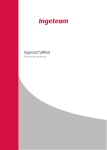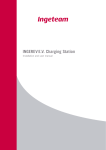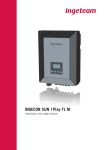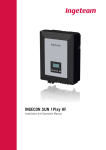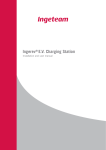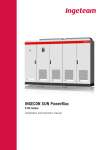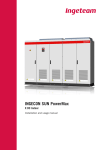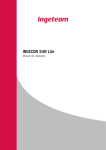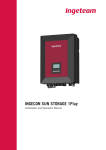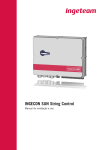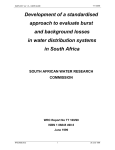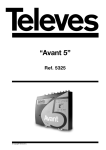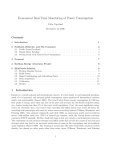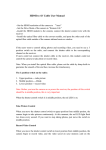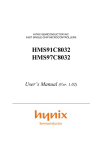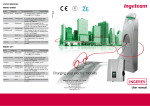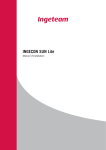Download Ingecon® μWind
Transcript
Ingecon® μWind Installation manual AAY2000IKI04_ 02/2012 Ingeteam Power Technology, S.A. Energy Avda. Ciudad de la Innovación, 13 31621 SARRIGUREN (Navarra) - Spain Tel.: +34 948 28 80 00 Fax.: +34 948 28 80 01 e-mail: [email protected] Service Call Center: +34 948 698 715 The copy, distribution or use of this document or of its content requires written authorisation. Any breach thereof will be reported for damages. All rights reserved including those of patent rights or design registration. The conformity of the document content with the hardware described has been checked. However, discrepancies may exist. Liability will not be assumed for total concordance. The information contained in this document is regularly reviewed and it is possible that there may be changes in subsequent editions. Other functions may be available which are not covered by this document. This document may be changed. Installation manual Ingeteam Power Technology, S.A. Important safety precautions This manual contains important instructions for the installation, handling and use of the following models: Ingecon® μWind 2.5 TL Ingecon® μWind 2.5 Ingecon® μWind 3 TL Ingecon® μWind 3.3 Ingecon μWind 3.3 TL Ingecon® μWind 5 ® Ingecon® μWind 3.68 TL Ingecon® μWind 3.8 TL Ingecon® μWind 4.6 TL Ingecon® μWind 5 TL Ingecon® μWind 6 TL and any models derived from these. This manual should be read carefully and kept in a safe place. General warnings The operations described in the manual may be performed only by qualified personnel. The status of qualified personnel referred to in this manual will be, as a minimum, that which meets all the standards, regulations and laws regarding safety applicable to the tasks of installing and operating this unit. The responsibility for designating qualified personnel will always fall to the company to which the personnel belong. It is necessary to decide which workers are suitable or not for carrying out specific work to preserve their safety at the same time as complying with occupational safety legislation. These companies are responsible for providing appropriate training in electrical equipment to their personnel and for familiarising them with the contents of this manual. All applicable safety-related legislation for electrical work must be complied with. Danger of electric shock. Compliance with the safety instructions set out in this manual or in the suggested legislation does not imply exemption from other specific standards for the installation, place, country or other circumstances that affect the inverter. Opening the door of the housing does not imply there is no voltage inside. The risk of electric shock exists even after disconnecting from the grid, the wind generator and the auxiliary supplies. Only qualified personnel may open it, following the instructions in this manual. In units which include an isolating switch, never switch from OFF to ON without first ensuring there is no DC voltage entering the equipment. As long as the wind generator receives wind, the DC cables will be live. The entire manual must be read and understood in full prior to manipulating, installing or operating the unit. AAY2000IKI04 iii Ingeteam Power Technology, S.A. Installation manual Following is a list of the basic obligatory safety standards for each country: • RD 614/2001 and RD 1699/2011 in Spain. • CEI 11-27 in Italy. • DIN VDE 0105-100 and DIN VDE 1000-10 in Germany. • UTE C15-400 in France. Carry out all control and handling without voltage. As a minimum security measure in this operation, the so-called five golden rules should always be followed: 1. Disconnect 2. Prevent any possible resupply 3. Check there is no voltage 4. Ground and short circuit the equipment 5. Protect from live elements, if any, and put up safety signs around the work zone. Until these five steps are completed, the work area cannot be considered voltage-free and any work performed will be considered to be work on live equipment. Category III - 1000-Volt measuring instruments must be used for checking for the absence of voltage. Ingeteam accepts no liability for any damages caused by improper use of the equipment. iv AAY2000IKI04 Installation manual Ingeteam Power Technology, S.A. Potential hazards for people Bear in mind the following warnings concerning personal safety. DANGER: Electric shock. The equipment may remain charged after disconnecting the wind generator and mains power. Carefully follow the mandatory steps in the manual for removing the voltage. DANGER: Explosion. There is a very low risk of explosion in very specific cases of malfunction. The casing will protect people and property from the explosion only if it is correctly closed. DANGER: Crushing and joint injuries. Always follow the indications in the manual on moving and placing the unit. The weight of this unit can cause lesions, serious injury and even death if not handled correctly. DANGER: High temperature. The flow of air from the side and top outlets can reach high temperatures which can cause injury to people exposed. The back and side of the unit act as a radiator. Do not touch, danger of severe burns. AAY2000IKI04 v Ingeteam Power Technology, S.A. Installation manual Potential hazards for the equipment Bear in mind the following warnings concerning protection of the equipment. Should the grid or the invertor fail, on power will be extracted from the wind turbine, and so the wind generator must have a braking system or additional speed limiting to guarantee it never exceeds the equipment’s maximum operating limits (Vdcmax= 550 V). CAUTION: Ventilation. The unit requires quality air flow while it is operating. Keeping the unit in the upright position and the inlets free of obstacles is essential for this air flow to reach the inside. CAUTION: Connections. After all duly authorised handling, check that the inverter is ready to start operation. Only after this can it be connected following the instructions in the manual. Do not touch boards or electronic components. The most sensitive components can be damaged or destroyed by static electricity. Do not disconnect or connect any terminal while the unit is operating. Disconnect and check for absence of voltage first. Personal protection equipment (PPE) Use all items comprising the protection equipment. Chapter “4. Safety instructions” contains references to the use of this equipment depending on the situation. The standard personal protective equipment is: vi • Safety goggles for mechanical hazards • Safety goggles for electrical hazards • Safety footwear • Helmet AAY2000IKI04 Installation manual Ingeteam Power Technology, S.A. Table of Contents 1. Overview..................................................................................................................................................9 1.1. Introduction......................................................................................................................................9 1.2. Equipment description.......................................................................................................................9 1.2.1. Models.....................................................................................................................................9 1.2.2. Options....................................................................................................................................9 1.2.3. System description....................................................................................................................9 1.2.4. Ingecon® μWind Interface (IWI)................................................................................................11 1.2.5. Compositions..........................................................................................................................11 1.3. Compliance with regulations.............................................................................................................12 1.3.1. CE marking.............................................................................................................................12 Low Voltage Directive....................................................................................................................12 Electromagnetic Compatibility Directive..........................................................................................12 1.3.2. VDE0126-1-1 and VDE-AR-N 4105...........................................................................................12 1.3.3. Regulations for connection to the ENEL Distribuzione grid...........................................................12 1.3.4. Engineering Recommendations G83/1-1....................................................................................12 2. System description..................................................................................................................................13 2.1. Location.........................................................................................................................................13 2.1.1. Environment............................................................................................................................13 2.1.2. IP rating.................................................................................................................................13 2.1.3. Ambient temperature...............................................................................................................13 2.1.4. Atmospheric conditions............................................................................................................13 2.1.5. Contamination class................................................................................................................13 2.1.6. Acoustic contamination............................................................................................................14 2.1.7. Ventilation...............................................................................................................................14 2.1.8. Support surface and fastening..................................................................................................15 2.2. Environmental characteristics...........................................................................................................16 2.3. EMC requirements...........................................................................................................................16 3. Operating, conservation and transport conditions........................................................................................17 3.1. Equipment reception........................................................................................................................17 3.2. Handling........................................................................................................................................19 3.3. Transport.......................................................................................................................................19 3.4. Storage..........................................................................................................................................20 3.5. Conservation...................................................................................................................................20 3.6. Waste handling...............................................................................................................................20 4. Safety instructions..................................................................................................................................21 4.1. Contents.........................................................................................................................................21 4.2. Symbols.........................................................................................................................................21 4.3. Definition of tasks to be carried out...................................................................................................21 4.3.1. Inspection tasks......................................................................................................................22 4.3.2. Control tasks..........................................................................................................................22 4.3.3. Handling tasks........................................................................................................................22 4.4. General..........................................................................................................................................22 4.4.1. General risks existing and preventive measures...........................................................................23 4.4.2. Additional risks and measures in handling tasks.........................................................................23 4.4.3. Personal Protection Equipment (PPE)........................................................................................23 4.5. Inspection, control and handling tasks...............................................................................................24 4.5.1. Inspection tasks......................................................................................................................24 4.5.2. Control tasks..........................................................................................................................24 4.5.3. Handling tasks........................................................................................................................24 5. Installation.............................................................................................................................................25 5.1. General requirements for installation.................................................................................................25 5.2. Fixing the unit to the wall.................................................................................................................25 TL units......................................................................................................................................25 Units with a transformer................................................................................................................26 5.3. Electrical connection.......................................................................................................................28 5.3.1. Description of cable inlets........................................................................................................29 Quick connectors for DC connection...............................................................................................29 AAY2000IKI04 vii Ingeteam Power Technology, S.A. Installation manual Quick connector for AC connection.................................................................................................29 Quick connector for communications..............................................................................................29 Multi-purpose glands....................................................................................................................29 DC circuit breaker........................................................................................................................30 Ingecon® μWind Interface (IWI) Connector.....................................................................................30 Transformer connectors.................................................................................................................30 5.3.2. Order of connecting the unit.....................................................................................................30 5.3.3. System wiring diagram.............................................................................................................30 5.3.4. Multi-purpose access..............................................................................................................31 5.3.5. Connection for communication via RS-485 serial port................................................................32 5.3.6. Connection for communication by other means..........................................................................32 5.3.7. Connection to ground and to the electricity grid..........................................................................32 Protection of the connection to the electricity grid...........................................................................32 5.3.8. Wind generator connection.......................................................................................................33 5.4. Electrical disconnection...................................................................................................................33 6. Commissioning.......................................................................................................................................35 6.1. Equipment inspection......................................................................................................................35 6.1.1. Inspection..............................................................................................................................35 6.1.2. Hermetic sealing of the unit.....................................................................................................35 6.2. Start-up.........................................................................................................................................36 6.2.1. Configuration of the MPP curve.................................................................................................36 6.2.2. Settings.................................................................................................................................37 7. Preventive maintenance............................................................................................................................38 7.1. Maintenance tasks...........................................................................................................................38 8. Display control........................................................................................................................................39 8.1. Keypad and LEDs............................................................................................................................39 8.2. Display...........................................................................................................................................39 8.3. Main menu.....................................................................................................................................40 8.4. Monitoring......................................................................................................................................40 8.5. Configuration..................................................................................................................................42 8.5.1. Country/Regulations.................................................................................................................42 8.5.2. Nominal grid voltage.............................................................................................................. 44 8.5.3. Grounding..............................................................................................................................45 8.5.4. V/f Adjustments......................................................................................................................45 8.5.5. Auxiliary relay.........................................................................................................................46 Insulation fault.............................................................................................................................46 Grid connection............................................................................................................................47 V/f Limits....................................................................................................................................47 Limiting power.............................................................................................................................47 8.6. Language selection........................................................................................................................ 48 8.7. Change date................................................................................................................................... 48 8.8. Start/Stop..................................................................................................................................... 48 8.9. Reset partial data............................................................................................................................49 8.10. Change inverter number.................................................................................................................49 8.11. Autotest.......................................................................................................................................50 9. Troubleshooting.......................................................................................................................................52 9.1. LED messages................................................................................................................................52 9.1.1. Green LED..............................................................................................................................52 9.1.2. Orange LED............................................................................................................................52 9.1.3. Red LED................................................................................................................................53 viii AAY2000IKI04 Installation manual Ingeteam Power Technology, S.A. 1. Overview 1.1. Introduction The purpose of this manual is to describe the Ingecon® μWind unit and to give appropriate information for its correct receipt, installation, start-up, operation and maintenance. 1.2. Equipment description An inverter is a circuit used to convert direct current to alternating current. The function of the Ingecon® μWind units is to convert the direct current generated by wind generators to alternating current and so enable it to be fed to the electricity grid. 1.2.1. Models The main models in the Ingecon® μWind range are: Ingecon® μWind 2.5 TL Ingecon® μWind 2.5 Ingecon® μWind 3 TL Ingecon® μWind 3.3 Ingecon μWind 3.3 TL Ingecon® μWind 5 ® Ingecon® μWind 3.68 TL Ingecon® μWind 3.8 TL Ingecon® μWind 4.6 TL Ingecon® μWind 5 TL Ingecon® μWind 6 TL 1.2.2. Options All these models in the Ingecon® μWind range may incorporate the following options: • DC circuit breaker • MC3-type quick connectors • Ingecon® μWind Interface (IWI) connection kit AAY0089 1.2.3. System description There are several configurations available depending on the features of the equipment being used. These possibilities are discussed below. A microgeneration wind power system must have a braking and stopping system in order to ensure the safety of people and the equipment. If the braking and stopping system is supplied by others, Ingeteam accepts no responsibility for any malfunction or the consequences thereof. Wind generator with DC output and built-in braking system grid wind generator Ingecon μWind ® DC AAY2000IKI04 AC 9 Ingeteam Power Technology, S.A. Installation manual Wind generator with AC output and built-in braking system In this case an AC-DC conversion system will be required to change the generator output voltage to DC. wind generator Ingecon® μWind conversion system AC DC grid AC Wind generator with DC output with no built-in braking system An external braking system is needed to be able to stop the wind generator or reduce the angular velocity. heating resistor wind generator Ingecon® μWind braking system DC DC grid AC Wind generator with AC output with no built-in braking system An external braking system is needed to be able to stop the wind generator or reduce itsangular velocity, as well as another system to convert from AC to DC before the current reaches the Ingecon® μWind unit. heating resistor wind generator braking and conversion system AC 10 DC Ingecon® μWind grid AC AAY2000IKI04 Installation manual Ingeteam Power Technology, S.A. 1.2.4. Ingecon® μWind Interface (IWI) As explained in the previous point, it is necessary in some circumstances to provide an external braking system and/ or an AC-DC conversion system. To fulfill this need, Ingeteam has included the Ingecon® μWind Interface unit in its range of products. The Ingecon® μWind Interface unit was designed to work in conjunction with Ingecon® μWind converters in the control and conversion of energy generated by the wind turbine. The purpose of this unit is to perform the following functions: • Convert from AC to DC, changing the AC voltage generated by the wind generator to DC for the Ingecon® μWind unit. • Protect the system from excess rotational speed and overvoltage, as well as limiting power capture when the generator is working in high wind speeds. • Shut down the wind generator. • Remotely control the installation and monitor additional variables of the wind power installation. With its ability to convert AC to DC, the Ingecon® μWind Interface allows wind generators with a DC output to be connected too. In this case the protection, monitoring and remote control functions will still be utilised. resistors* wind generator Ingecon® μWind Ingecon® μWind Interface AC DC grid AC communications * The resistors are not included with the Ingecon® μWind Interface. The braking resistors must be dimensioned as explained in the Ingecon® μWind Interface (AAY2000IKI06) manual. Should this point not be complied with, Ingeteam will not guarantee the ability of the generator to brake and/or stop. For more information about Ingecon® μWind Interface and its operation in conjunction with Ingecon® μWind units, see Installation and User Manual “AAY2000IKI06”. 1.2.5. Compositions At the hardware level, there are small variations between units for different countries. However, although these differences are small, not all units can be configured to the options of every country. Refer to the configuration section for further information. AAY2000IKI04 11 Ingeteam Power Technology, S.A. Installation manual 1.3. Compliance with regulations This unit can incorporate kits making it adaptable to the regulations for all European countries and countries in other continents. 1.3.1. CE marking CE marking is mandatory for the sale of any pro duct within the European Union, without prejudice to standards or laws. Ingecon® μWind units have CE marking by reason of their compliance with the following directives: • Low Voltage Directive 2006/95/EC • Electromagnetic Compatibility Directive 2004/108/EC Low Voltage Directive Ingecon® μWind units comply with this directive by means of compliance with the applicable parts of harmonised standard EN 50178 Electronic equipment for use in power installations and EN 50438 Requirements for the connection of micro-generators in parallel with public low-voltage distribution networks. Electromagnetic Compatibility Directive Ingecon® μWind units comply with this directive by means of compliance with the applicable parts of harmonised standards: • EN 61000-6-2 Electromagnetic Compatibility. Part 6-2: Generic standards - Immunity for industrial environments. • EN 61000-6-3 Electromagnetic Compatibility. Part 6-3: Generic standards - Emission for domestic environments. Compliance with these standards calls for compliance with limits and procedures in other standards of the same series. 1.3.2. VDE0126-1-1 and VDE-AR-N 4105 In countries such as Germany, Portugal and France, incorporating a device of this type facilitates compliance with the regulations in force for wind power and microgeneration facilities. As such, our units comply with the standards: • VDE 0126-1-1 Automatic disconnection for generating installations connected in parallel with the low voltage grid. • VDE-AR-N 4105 Generators connected to the low voltage distribution network. Compliance with this standard must be requested on ordering the unit. 1.3.3. Regulations for connection to the ENEL Distribuzione grid In Italy, to connect to the company ENEL’s grid, it is necessary to comply with the regulations the company demands. Hence our units comply with the applicable part of standard: • RTC alle rete BT di Enel Distribuzione Compliance with this standard must be requested on ordering the unit. 1.3.4. Engineering Recommendations G83/1-1 In the United Kingdom there is document G83/1-1, which recommends the characteristics a microproduction generator needs to have: • Recommendations for the connection of small-scale embedded generators in parallel with public low-voltage distribution networks. Compliance with this standard must be requested on ordering the unit. 12 AAY2000IKI04 Installation manual Ingeteam Power Technology, S.A. 2. System description 2.1. Location Guidelines are provided in this section for choosing a suitable environment and adapting the unit to it properly. 2.1.1. Environment Place the units in a place which is accessible for installation and maintenance work and which permits use of the keyboard and the reading of the front indicator LEDs. Never place any object on top of the unit. The radiator can reach 85 °C. Do not place any material sensitive to the high surrounding air temperatures close to the inverter. 2.1.2. IP rating Ingecon® μWind units have an IP65 level of protection against external agents which enables them to be installed outdoors. IP65 means that the unit is fully protected against the ingress of dust and also against water jets from any direction as defined for this level of protection in standard IEC60529. However, excessive moisture can cause a safety shutdown of the unit to protect it. Hence the following is recommended: Locate the units in a place protected from rain and avoiding corrosive atmospheres. 2.1.3. Ambient temperature Ingecon® μWind units are designed to operate at between -20 °C and +70 °C. To operate in HT mode, the maximum ambient temperature must not exceed 45 °C. To operate in HP mode, the maximum ambient temperature must not exceed 40 °C. 2.1.4. Atmospheric conditions The ambient air must be clean and relative humidity must not exceed 50% at over 40 °C. Higher levels of relative humidity, up to 95%, can be tolerated at below 30 °C. It should be borne in mind that moderate condensation may occasionally occur as a consequence of temperature variations and, apart from the unit’s own protection, vigilance of these units is necessary once they have been started up on sites where it is suspected that the conditions described above will not be present. 2.1.5. Contamination class The pollution degree for which the units have been designed is level 3. AAY2000IKI04 13 Ingeteam Power Technology, S.A. Installation manual 2.1.6. Acoustic contamination When on, the inverter generates a slight buzzing sound. Do not place it in an occupied room, or on light supports which might amplify this buzz. The mounting surface must be firm and appropriate for the weight of the unit. 2.1.7. Ventilation Ingecon® μWind TL Ingecon® μWind A zone of 30 cm above the unit and 20 cm below and at the sides must be left free of obstacles. Only in this way will the unit’s cooling system operate correctly. The cooling system designed for the unit varies from one unit to another as greater heating occurs at higher power and this requires greater air flow to cool it. This is why some models are cooled by means of natural convection and others use forced convection with one or two fans. Natural convection • Ingecon® μWind 2.5 • Ingecon® μWind 2.5 TL • Ingecon® μWind 3 TL Forced convection (1 fan) 14 • Ingecon® μWind 3.3 • Ingecon® μWind 3.3 TL • Ingecon® μWind 3.68 TL AAY2000IKI04 Installation manual Ingeteam Power Technology, S.A. Forced convection (2 fans) • Ingecon® μWind 3.8 TL • Ingecon® μWind 4.6 TL • Ingecon® μWind 5 • Ingecon® μWind 5 TL • Ingecon® μWind 6 TL 2.1.8. Support surface and fastening To guarantee good heat evacuation and promote sealing, the units must be placed on a perfectly vertical wall or, failing this, with a slight slope of a maximum of +10° or -10° with respect to the vertical. >10º >10º >10º >10º A solid wall must be reserved for fixing the inverter. It must be possible to drill the wall and fit suitable wall plugs and bolts to support the unit’s weight. In the Ingecon® μWind TL packaging you will find a full-scale template of the equipment to help you to mark the fixing holes in the wall. AAY2000IKI04 15 Ingeteam Power Technology, S.A. Installation manual For TL models, the distance between drilled holes will be as follows: 200 80 160 80 5 324 5 7, 7, 5 7, In models with transformers, it is the transformer which will be secured to the wall. The inverter will subsequently be fixed to the transformer. 100 100 257 O1 0 478,61 The three upper drilled holes are made first. The measurements to be used are shown in the figure. The bottom hole must be made when the unit is suspended, as explained in Section “5.2. Fixing the unit to the wall”. The figure shows the approximate distances between the horizontal line formed by the three upper drilled holes and where the bottom hole will be. It also shows the approximate vertical distance to the level of the top edge of the inverter, which will subsequently be attached to the transformer fixed to the wall. 2.2. Environmental characteristics The environmental conditions for operation are: Ambient conditions Minimum temperature -20 °C Minimum surrounding air temperature -20 °C Minimum surrounding air temperature 70 °C Maximum relative humidity without condensation 95% For further information see Chapter “3. Operating, conservation and transport conditions”. 2.3. EMC requirements The Ingecon® μWind units are equipped with the necessary filtering elements to comply with EMC requirements for industrial applications in order to prevent disturbances in other equipment outside the installation. 16 AAY2000IKI04 Installation manual Ingeteam Power Technology, S.A. 3. Operating, conservation and transport conditions Failure to follow the instructions provided in this section may lead to damage to the equipment. Ingeteam accepts no liability for damage resulting from the failure to follow these instructions. 3.1. Equipment reception Reception Upon receipt of the shipment, check the terms specified in the Delivery Note, sign the Signature Receiver Goods field and return the copy to the return address. Keep the unit in its packaging until immediately before installation. Maintain the unit upright at all times. If you have purchased inverters with transformers, the transformer and inverter will be received in separate boxes. It will be possible to identify which transformer corresponds to each unit by means of the serial number, shown on the shipping label: INGETEAM POWER TECHNOLOGY, S.A. Avda. Ciudad de la Innovación 13 31621 Sarriguren (Navarra) SPAIN www.ingeteam.com ingecon® μWind Model Ingecon® μWind 5 TL Code I+D AAYXXX S/N 100010060001 IP65 2011 Ingecon® μWind 5TL label INGETEAM POWER TECHNOLOGY, S.A. INGETEAM POWER TECHNOLOGY, S.A. Avda. Ciudad de la Innovación 13 31621 Sarriguren (Navarra) SPAIN www.ingeteam.com Avda. Ciudad de la Innovación 13 31621 Sarriguren (Navarra) SPAIN www.ingeteam.com ingecon® μWind ingecon® μWind Model Ingecon® μWind 5 Model Ingecon® μWind 5 Code I+D AAYXXX Code I+D AAYXXX S/N 100010060001 S/N 100010060001 TRANSFORMER IP65 2011 IP65 2011 Label for Ingecon® μWind 5 and transformer Unit packaging will be of the following size: AAY2000IKI04 17 Ingeteam Power Technology, S.A. Installation manual Model Packaging type Weight (kg) 2.5TL, 3TL and 2.5 (with no transformer) 20.3 3.3TL, 3.68TL and 3.3 (with no transformer) 21.7 3.8TL, 4.6TL, 5TL, 6TL and 5 (with no transformer) Cardboard box with foam Length x Depth x Height (mm) 600 x 400 x 250 25.3 Transformer 2.5 and transformer 3.3. 27 Transformer 5 43.7 Unpacking The serial number (S/N) of the equipment is its unique identifier. This number must be quoted in any communication with Ingeteam. INGETEAM POWER TECHNOLOGY, S.A. Avenida Ciudad de la Innovación 13 31621 Sarriguren (Spain) www.ingeteam.com Ingecon® μWind Ingecon® μWind 2.5 TL 25 A 5000 30 65 W A ºC -20 ºC/ 45 ºC IP65 ción Protec de Fecha ción fabrica PAC: 2500 W VAC: 230 VAC FAC: 50 Hz Cos φ: 1 VDC: 125-550 VDC Std: S/N 100110070001 IP65 2011 Never stack more than 20 TL units or more than 10 units with their transformers on a Europallet. In the case of units with transformers, the transformers must be laid on the first two layers and half the third. Transport damage If the equipment has been damaged during transport: 1. Do not proceed with the installation. 2. Notify the distributor immediately within 5 days of receipt of the equipment. If ultimately the unit has to be returned to the manufacturer, you must use the same original packaging. Separating the packaging All the packaging can be delivered to a non-hazardous waste management company. 18 AAY2000IKI04 Installation manual Ingeteam Power Technology, S.A. In any event, each part of the packaging may be recycled as follows: • Plastic (polystyrene, bag and bubble wrap): Appropriate container (plastic and bottles). • Cardboard: Appropriate container (paper and cardboard). 3.2. Handling Correct handling of the units is vitally important in order to: • Prevent damage to the packaging which enables them to be kept in optimum condition from shipping until they are unpacked. • Avoid knocks and/or falls which may harm their mechanical characteristics, e.g. cause incorrect closure of the housing, loss of IP rating, etc. • Avoid, as far as possible, vibrations which may cause subsequent malfunction. If you observe any anomaly, please contact Ingeteam immediately. 3.3. Transport Appropriate transport and storage of the unit are the necessary first steps for correct use and operation. Taking Section “3.2. Handling” into account and as a preventive measure, Ingeteam recommends the use of transport companies specialised in the transport of special and/or fragile equipment. All units packaged according to Section “3.2. Handling” must be handled with tools to prevent damage to the packaging. The unit must be protected during transport and storage from mechanical knocks, vibrations, water splashes (rain) and any other product or situation which may damage it or alter its behaviour. Transport over distances of greater than 5 metres must be carried out using a pallet truck or forklift truck, whenever possible. Transport using a pallet truck At least the following requirements should be observed: 1. Place the packaged units centred with respect to the forks. 2. Try to locate them as close as possible to the connection between the forks and the steering unit. 3. In all cases, observe the instructions in the pallet truck’s user manual. Transport using a forklift truck At least the following requirements should be observed: 1. Place the packaged units centred with respect to the forks. 2. Try to locate them as close as possible to the connection between the forks and the steering unit. 3. Ensure that the forks are perfectly level to avoid overturning the unit. 4. In any case, observe the instructions in the forklift truck’s user manual. Once the unit has been transported to the place where it is to be located and only when it is to be installed, unpack the unit. Transport of the unpackaged unit At least the following requirements should be observed: 1. Use the two side holes to grasp the unit with both hands. 2. Follow the necessary ergonomic advice for lifting weights. The unit weighs between 21 and 24 kg, depending on its power. 3. Do not release the unit until it is perfectly secured or placed. 4. Ask someone else to guide the movements to be made. AAY2000IKI04 19 Ingeteam Power Technology, S.A. Installation manual 3.4. Storage If the unit is not installed immediately after receipt, the following points should be taken into account in order to prevent damage: • The package must be stored in the position in which the box arrived. • Keep the unit free of dirt (dust, shavings, grease, etc.) and away from rodents. • Keep away from water splashes, welding sparks, etc. • Cover the unit with a breathable protective material in order to prevent condensation due to ambient humidity. • Units in storage must not be subjected to climate conditions other than those indicated in Section “2.2. Environmental characteristics”. • It is very important to protect the unit from chemical products which can cause corrosion, as well as from salty atmospheres. 3.5. Conservation In order to permit correct conservation of the units, they must not be removed from their original packaging until it is time to install them. In case of prolonged storage, the use of dry places avoiding, as far as possible, sharp changes in temperature is recommended. Deterioration of the packaging (tears, holes, etc.) prevents the units from being kept in optimum conditions before installation. Ingeteam Energy, S.A. accepts no liability for damage in the case of failing to observe this condition. 3.6. Waste handling During the various processes for installation, start-up and maintenance, waste is generated which must be handled appropriately according to the regulations in the corresponding country. At the end of the unit’s life, the waste must be processed by an authorised waste management company. Ingeteam, in accordance with its policy of respect for the environment, will inform the authorised manager, via this Section, of the location of components to be decontaminated. The elements within the unit that must be handled individually are: 1. Electrolytic condensers or condensers containing PCB 2. Batteries and accumulators 3. Printed circuit cards 4. Liquid crystal displays 1 2 4 3 20 AAY2000IKI04 Installation manual Ingeteam Power Technology, S.A. 4. Safety instructions 4.1. Contents This section contains safety instructions which must be followed when installing, operating and accessing the unit. Failure to comply with these instructions may cause injury or even death or cause damage to the unit. Read this section carefully before working on the unit. 4.2. Symbols The warnings advise of conditions which may cause serious injury or death and/or damage to the equipment. The means of avoiding the hazard to both people and the unit is indicated along with the warning. The symbols and an explanation of their meaning can be seen below. DANGER: Electric shock Dangerous voltage warning: Warns of high voltage which can cause injury or even death and/or damage to the equipment. General warning: Warns of conditions which might cause injury and/or damage to the equipment. Caution hot surface: Warns of the existence of hot parts which may cause serious burns. The specific safety warnings and notes which affect specific tasks are included in each affected chapter and are repeated and completed in the corresponding critical points. Please read this information carefully as it is written for your personal safety and to ensure the longest possible service life for the unit and the devices to which it is connected. 4.3. Definition of tasks to be carried out Installation, start-up, inspection and maintenance operations may only be carried out by personnel appropriately qualified and trained in electrical subjects (hereinafter qualified personnel). You are reminded of the obligation to comply with the legislation applicable to electrical work. An open enclosure never implies an absence of voltage in the unit, so only qualified personnel may access the unit, following the safe operation guidelines stipulated in this document at all times. The set of conditions listed below should be considered as minimum requirements. It is always preferable to shut off the general power. Installation defects may result in unwanted feedback. Danger of electric shock. AAY2000IKI04 21 Ingeteam Power Technology, S.A. Installation manual In addition to the safety measures indicated in this manual, the general measures that apply in this area (specific to the installation, country, etc.) must be taken into account. The electrical installation must not involve a risk of fire or explosion. Workers must be duly protected against accident risks from direct or indirect contact. The electrical installation and protection devices must take the voltage, the external determining factors and the competence of the people who have access to parts of the installation into account. All equipment must be appropriate to protect exposed workers against the risk of direct or indirect contacts. In any case, the electrical parts of the work equipment must comply with that laid down in the corresponding specific regulations. All workers who carry out work outdoors must suspend their work in the case of storms, rain or strong winds, snow or any other unfavourable environmental condition which makes visibility or handling tools difficult. Work on installations directly connected to overhead electricity lines must be interrupted in the case of storms. Ingeteam accepts no liability for any damages caused by improper use of the equipment. Any work carried out on any equipment which implies a modification of the original electrical arrangements must be proposed in advance to Ingeteam. These must be studied and approved by Ingeteam. The necessary means must be arranged to prevent people from outside the installation approaching or handling the equipment: • Warning signs cautioning that there are people working. • Elements for setting or mechanical locking. These instructions must be easily accessible close to the unit and located within reach of all users. Before installation and start-up, read these safety instructions and warnings carefully as well as all the notices located on the unit. Ensure that all the notices are perfectly legible and that those which are damaged or have disappeared are restored. 4.3.1. Inspection tasks May involve opening the housing for visual inspection tasks. 4.3.2. Control tasks Tasks to load software from the communications connector. 4.3.3. Handling tasks Tasks for the mounting and/or replacement of parts (fuses, switchgear in general, etc.), tasks for disconnecting and reconnecting voltage, connecting the inverters to equipment and connecting communications cabling to the equipment. All those tasks which are neither Inspection or Control will be considered to be Handling. 4.4. General This section defines the preventive measures to take to carry out all types of tasks on the unit, working safely and controlling risks which cannot be avoided. Protection against direct contact is by means of the housing, which has IP65 protection class. The unit has been tested according to the applicable regulations to comply with the safety requirements, the values 22 AAY2000IKI04 Installation manual Ingeteam Power Technology, S.A. for insulation distances and leakage paths for the voltages used. The tools and/or equipment used in handling tasks must have double reinforced insulation (Class II). 4.4.1. General risks existing and preventive measures Impact against immovable objects • Inform workers of the risk. • Adequate lighting. • Work with care. • Keep sufficient distance to prevent contact with the part causing the risk. Knocks, punctures and cuts from objects and/or tools • Keep the lid closed if not working on the inside. • Adequate lighting. • Order and cleanliness. • Mandatory use of hard hat, safety footwear and gloves when necessary. Flying particles (fan) • Recommended use of anti-impact glasses when accessing the fan inlet and outlet zones. • Electrical danger. • Comply with that laid down in the Sections “4.4.3. Personal Protection Equipment (PPE)” and “Important safety precautions”. • Inform the worker of the risk. • Comply with the legislation applicable to the installation in which the unit is located, both that for the type of installation and the country where it is located. 4.4.2. Additional risks and measures in handling tasks Thermal contact • Inform workers of the risk. • Recommended use of gloves. • Disconnect the power and wait 10 minutes for the hot parts inside the unit (internal radiator) to cool. 4.4.3. Personal Protection Equipment (PPE) The preventive maintenance tasks involve Inspection, Control and/or Handling actions, depending on each case. Inspection The use of safety footwear to standard EN 345-1:1992 is mandatory. The use of kid leather type gloves is also mandatory. Control The use of safety footwear to standard EN 345-1:1992 is mandatory. The use of kid leather type gloves is also mandatory. Handling The use of safety footwear to standard EN 345-1:1992 is mandatory. The use of kid leather type gloves is also mandatory. It is also mandatory to use dielectric gloves meeting standard EN 60903-1992 and protective face mask against AAY2000IKI04 23 Ingeteam Power Technology, S.A. Installation manual electric shock complying with EN 168-1994 for voltage testing tasks and opening or closing automatic switches under load. 4.5. Inspection, control and handling tasks The mandatory safety measures necessary in carrying out inspection, control and/or handling tasks on this unit are defined below. Opening method: The cover is opened and closed using a system requiring tools to remove it (nuts and bolts). It is strictly forbidden to gain access to the inside of the equipment through any other point than the access cover provided for the purpose. 4.5.1. Inspection tasks Access inside of the unit for inspection only via the front cover. After completing the inspection, replace the front cover and secure it with the bolts supplied. 4.5.2. Control tasks The only control task which can be carried out on this unit is the loading of software from the quick communications connector located on the outside. 4.5.3. Handling tasks All those tasks which are neither Inspection or Control will be considered to be Handling. Before handling the equipment, ensure there is no voltage present. To achieve this, use the following protocol: 1. Shut down the unit. 2. Block the wind generator if a braking system is available. 3. Disconnect the inverter DC input cable, isolate it, mark it and protect it. 4. Disconnect the Vac cable. 5. Wait 10 minutes for the internal capacitances to discharge, the hot parts to cool and the inverter’s fan blades to stop turning. 6. Open the door and discharge the Vbus by means of a suitable discharge resistance between the +VBUS and -VBUS. Check there is no voltage To carry out steps 2, 3, 4, 5 and 6, it will be necessary to use the PPE indicated in Section “4.4.3. Personal Protection Equipment (PPE)” in this document for work with live parts. Any work carried out which implies a modification of the original electrical settings must be proposed to and accepted by Ingeteam. 24 AAY2000IKI04 Installation manual Ingeteam Power Technology, S.A. 5. Installation Before installing the Ingecon® μWind unit, the packaging must be removed, taking special care not to damage the housing. The inside of the box must be checked to ensure there is no moisture. If there are signs of moisture, the unit must not be installed until it is completely dry. All installation operations must obey the regulations in force. Before starting the actions described under this point, it is important to identify each of the parts described in it and to have gathered the necessary tools to carry them out. 5.1. General requirements for installation • The unit’s environment must be appropriate and meet the guidelines described in Chapter “2. System description”. Additionally, the parts used in the rest of the installation must be compatible with the unit and comply with the applicable legislation. • Ventilation and the space for work, which must be suitable for maintenance tasks according to the applicable regulations in force. • The external connection devices, which must be suitable and sufficiently close as set forth in current regulations. • The connecting cables must be of the appropriate section for the maximum current. • Special care must be taken to ensure that there are no external elements near the air inlets and outlets to obstruct proper ventilation of the unit. 5.2. Fixing the unit to the wall Ingecon® μWind units have a system for anchoring to the wall, using a fixing plate. TL units 1. Mark the attachment points for the plate on the wall. Use the template provided with the unit. 2. Drill holes in the wall with a bit recommended for the screws to be used to secure the plate to the wall later. 3. Fix the plate using wall plugs and stainless steel screws to prevent corrosion. Use fittings appropriate for the weight of the unit. AAY2000IKI04 25 Ingeteam Power Technology, S.A. 4. Suspend the unit from the plate. 5. Screw on the bottom attachment. 6. Check that the unit is properly secured. Installation manual Units with a transformer The top attachment plate for the unit supports the weight. The bottom point fixes the transformer to the wall and prevents vibrations. Fix the transformer to the wall before coupling the equipment to it. Fixing the transformer to the wall 1. Mark the attachment points for the plate on the wall. 2. Drill holes in the wall with a bit recommended for the screws to be used to secure the plate to the wall later. 3. Fix the plate using wall plugs and stainless steel screws to prevent corrosion. It is important to choose screws, washers and plugs which are suitable for the bolts which will fix the plate depending on the specific conditions of each installation. 26 AAY2000IKI04 Installation manual Ingeteam Power Technology, S.A. 4. Suspend the transformer from the plate. This operation must be carried out between two people. 5. Screw on the bottom attachment. 6. Check that the transformer is secured well. Fixing the unit to the transformer 7. Suspend the inverter on the transformer by fitting the holes in the former onto the lugs at the top of the transformer. 8. Adjust the two housings so that their edges coincide and are parallel, so that the drilled plates at the rear bottom right of the inverter and the front bottom right part of the transformer are in contact and their drilled parts coincide. 9. To join the inverter and transformer together, the choice can be made between a nut and bolt or the use of a padlock. Unit-to-transformer junction AAY2000IKI04 27 Ingeteam Power Technology, S.A. Installation manual 10. Check that the transformer is secured well. 5.3. Electrical connection Once the unit has been mounted in its final position and has been solidly secured, make the electrical connections to it. quick connectors for DC IWI connector (optional) DC circuit breaker (optional) 28 fan/ fans/ radiator communications connector fuse transformer connection quick connector for AC AAY2000IKI04 Installation manual Ingeteam Power Technology, S.A. 5.3.1. Description of cable inlets Ingecon® μWind units have cable inlets through the bottom of the housing. Each type is described below. Quick connectors for DC connection The cables from the wind generator may be connected using the following quick connectors. The packaging includes two cables fitted with aerial connectors at one end for connecting directly to the inverter. Note that these are marked + and -. Respect the polarity. Quick DC connectors Quick connector for AC connection This is a Wieland quick two pole connector plus ground. Quick AC connectors Quick connector for communications This is a female quick connector. A cable with a compatible connector must be connected. Quick connectors for communications Multi-purpose glands Multi-purpose cable glands can be requested as an option. If these are not requested, the plate will be supplied with its hole pre-cut to be able to open it. If the hole is opened and a cable gland is not fitted for correctly installed units, the unit will lose its IP65 protection rating. Two to six M12 cable glands and/or one M20 cable gland are suitable for one or more cables. This entrance can be used for: • Access to the DC connection by cable • Access to the insulation fault contact • Access for other accessories AAY2000IKI04 Knock-out holes 29 Ingeteam Power Technology, S.A. Installation manual DC circuit breaker Ingecon® μWind units (with or without transformers) may have an optional DC isolating switch. There are several different models, although they all have the same electrical properties. The advantage provided by this isolator is that it can isolate under load in case of emergency. In any case, we recommend that other than in the case of an emergency, the unit be shut down by means of the display before isolating. DC circuit breaker As long as the wind generator receives wind, the DC cables will carry potentially dangerous voltage levels. Never handle the connections before disconnecting the inverter from the grid and the wind generator. Ingecon® μWind Interface (IWI) Connector You may optionally request the inverter to be fitted with a connector for connecting to the Ingecon® μWind Interface. IWI connector Transformer connectors Ingecon® μWind units with transformer are supplied with the inverter and transformer in separate boxes. They must be connected when installed using the cable supplied with the transformer. The connectors to link are as shown in the figure. Connectors to be joined 5.3.2. Order of connecting the unit The basic connections to be made with the inverter are as follows, in this order: 1. Connecting auxiliary equipment (optional). 2. Communication line (optional). 3. Connecting the inverter and the transformer in units which include one. 4. Connecting the inverter to the grid. 5. Connecting the Ingecon® μWind Interface communications cable (optional). 6. Connecting the DC cables from the wind generator or the Ingecon® μWind Interface (depending on the configuration selected). The following sections describe how to make these connections. 5.3.3. System wiring diagram The layout will correspond to those in the figures in the majority of installations. The regulations applicable to each installation and to each country in which the inverter is located must always be observed. 30 AAY2000IKI04 Installation manual Ingeteam Power Technology, S.A. TL unit electrical diagram For Ingecon® μWind 2.5TL, 3TL, 3.3TL, 3.68TL, 4.6TL, 5TL and 6TL. Electricity company panel wind generator thermomagnetic circuit breaker inverter counter kWh grid Electrical diagram for units with transformers For Ingecon® μWind 2.5, 3.3 and 5. Electricity company panel wind generator inverter transformer thermomagnetic circuit breaker counter kWh grid Electrical wiring diagram for TL equipment with a connection to Ingecon® μWind Interface (IWI) For Ingecon® μWind 2.5TL, 3TL, 3.3TL, 3.68TL, 4.6TL, 5TL and 6TL with a connection to Ingecon® μWind Interface. IWI inverter Electricity company panel thermomagnetic circuit breaker wind generator counter kWh grid Electrical wiring diagram for transformers with a connection to Ingecon® μWind Interface (IWI) For Ingecon® μWind 2.5, 3.3 and 5 with a connection to Ingecon® μWind Interface. IWI wind generator Electricity company panel inverter transformer thermomagnetic circuit breaker counter kWh grid 5.3.4. Multi-purpose access The orifices provided for this function can be opened by breaking the knock-out in the unit’s base. Once the orifices have been opened, they must be fitted with M12 and/or M20 metric cable glands which accept pipes of a diameter between 3.5 and 7 mm for M12 and between 7 and 13 mm for M20. Once the connection has been made, check that the cable glands used have been properly fitted to guarantee sealing of the box. A closure which is not sealed may allow moisture to enter and seriously damage the unit, invalidating the manufacturer’s warranty in addition. If a knock-out which is not to be used is opened accidentally or one which has been fitted with a cable gland is no AAY2000IKI04 31 Ingeteam Power Technology, S.A. Installation manual longer used, these open orifices must be closed with a sealing plug which maintains the unit’s hermetic seal. 5.3.5. Connection for communication via RS-485 serial port All Ingecon® μWind units have communication facilities over an RS-485 serial line. As the RS-485 communication board is already wired to the Harting HAN® 4 A female connector, simply plug in a male connector of the same type. Refer to “AAX2002IKI01 Installation Guide for Communications Devices” for how to wire correctly the male connectors which need to be plugged into the connector on the inverter. This connector can be supplied by Ingeteam if requested together with the unit. 5.3.6. Connection for communication by other means At the request of the installer, inverters may optionally incorporate hardware for communicating via: • GSM/GPRS telephone • Ethernet In all these units, the auxiliary signals connect directly to the corresponding communications card. See the Communications Accessories Manual “AAX2002IKI01”. 5.3.7. Connection to ground and to the electricity grid The inverter’s metal parts (unit ground) are electrically connected to the ground pin in the grid connection quick connector. To ensure the safety of personnel, this terminal must be connected to the installation’s ground. The connection of the grid Neutral and Phase to the inverter is made by means of a three-terminal connector. The maximum diameter of the cable pipe permissible for the connector is 14 mm. If the inverter and the grid connection point are far enough apart to require the use of cables of a greater section, an external junction box close to the inverter to make this section change is recommended. Protection of the connection to the electricity grid It is necessary to install protection elements in the connection between the inverter and the electricity grid. Thermomagnetic circuit breaker A thermomagnetic circuit breaker and/or fuse must be installed in the connection from the inverter to the electricity grid. The following table provides the necessary data for the selection of these devices by the installer. All data in Amperes. Ingecon® μWind Maximum inverter current Rated current for the gL-type fuse Rated current for the type B MCB 2.5 TL 13 20 20 3 TL 17 25 20 3.3 TL 17 25 20 3.68 TL 17 25 25 3.8 TL 18.8 25 25 4.6 TL 24.4 32 25 5 TL 25.5 32 32 6 TL 26.2 32 32 When selecting the protection in an installation, it must be borne in mind that its circuit breaking capacity needs to be higher than the grid connection point’s short-circuit current. It must be taken into account for correct selection of the protection that the ambient working temperature influences the maximum current permitted by these protections as indicated by the manufacturer. 32 AAY2000IKI04 Installation manual Ingeteam Power Technology, S.A. Differential circuit breaker Never install in the grid connection for TL units (with no transformer) a differential switch with a limit current below the maximum fault current which may occur in the wind farm installation under all its operating conditions. While feeding to the grid, a shunt current is produced from the metallic housings to ground, the value of which depends on the type of generator as well as atmospheric conditions (rain, snow, etc.). This service-conditioned shunt current must not exceed the breaking current value of the differential switch. If it does so, the connection of the inverter to the grid may trip the differential switch external to the inverter. The unit will need to be started up manually, as the Start/Stop status is conserved even if the inverter has been switched off. Section “8. Display control” provides connection details. 5.3.8. Wind generator connection The inverter is connected to the wind generator by means of quick connect terminals specifically designed for the purpose. This type of quick connect terminal requires the use of specific tools. Bear in mind at all times that whenever the wind generator is in movement there will be a voltage at its terminals. The inverter can therefore have voltages of up to 550 V inside even when not connected to the grid. The inverter needs a maximum system voltage of 550 V. Check that the wind generator configuration cannot supply this voltage to the inverter even under the most adverse conditions, e.g. an ambient temperature of -10 °C. In the case of damage due to the DC voltage exceeding 550 V, Ingeteam accepts no liability for such damage. Connect the positive pole of the wind generator to the terminal marked +, and the negative pole to the one marked -. The inverter’s factory-fitted terminals support a maximum current of 20 amperes. In units which include an isolating switch, never switch from OFF to ON without first ensuring there is no DC voltage at the input to the unit. Whenever the wind generator receives wind, there will be a voltage in the DC cables. 5.4. Electrical disconnection To disconnect the unit, follow the steps presented in Section “3. Operating, conservation and transport conditions” of this manual in reverse order. Take careful note of the following warning: There are electrical capacitances in the unit which can maintain high voltages even after having disconnected the inverter from the wind generator and the grid. Ingecon® μWind units may only be opened by authorised personnel. AAY2000IKI04 33 Ingeteam Power Technology, S.A. Installation manual During installation and maintenance operations on the units, the use of personal protective equipment, hard hat, gloves and safety footwear is mandatory. Do not touch the side or rear of the inverter, these can reach high temperatures. Installation work requiring opening the unit should be done in a dry environment, so that no moisture left inside could condense and damage the electronics. Ingeteam accepts no liability for any damages caused by improper use of the equipment. 34 AAY2000IKI04 Installation manual Ingeteam Power Technology, S.A. 6. Commissioning 6.1. Equipment inspection This section contains instructions on how to make the unit work once correctly wired and closed. Ingecon® μWind units manage a generating installation or part of one. The correct condition of this installation must be checked before start-up. Each installation is different, depending on its characteristics, the country in which it is located or other special conditions which may apply. In all cases, before starting up, it is necessary to ensure that the installation complies with the applicable legislation and regulations and that at least the part to be started up is complete. 6.1.1. Inspection Before inverter start-up, a general inspection of the units must be carried out involving mainly: Wiring check • Check that the cables are correctly connected to their connectors at the bottom of the housing. • Check that these cables are in a good condition and that there are no hazards in their environment which damage them, such as sources of intense heat, objects which could cut them or arrangements which put them at risk of impacts or pulls. Check the the unit is properly secured Check that the unit is secured firmly and is not at risk of falling. Isolating switch Check that the isolating switch is in the ON position. 6.1.2. Hermetic sealing of the unit It must be ensured during installation operations that the unit’s level of sealing has not been altered during connection of the unit. Check that the connectors are tight and the cable glands are properly sealed. Auxiliary connections In these connections through cable glands, give cable pipes sufficient length so that they do not pull on the internal electrical connection terminals. Make sure that the unused knock-outs have not been opened. Firmly tighten the cable glands to guarantee sealing. Display cable If the front cover has been opened at any time, ensure that the cable to the display remains firmly connected. Cover If the front cover has been opened at any time, attach it to the unit using its four screws as follows: 1. Lubricate the screws. 2. Ensure that the cover is correctly aligned with the housing. This can be confirmed easily by checking that the holes in the cover and the housing mate. 3. Manually insert the four screws into their threaded holes, starting at the top right, followed by the bottom left and finally the other two. 4. Tighten the screws until a maximum torque of 5 Nm is applied to each with a calibrated tool. 5. Check that sealing is conserved. AAY2000IKI04 35 Ingeteam Power Technology, S.A. Installation manual The guarantee does not cover damage caused by inadequate sealing of the unit. Whenever the unit is opened, it is mandatory to lubricate the screws before closing it again to prevent them seizing. 6.2. Start-up Once a general visual inspection, wiring check and sealing check has been carried out, proceed to connect power to the unit while keeping it switched off. The tasks outlined for this step must be carried out with the unit door always closed, thus avoiding possible contact with live parts. 6.2.1. Configuration of the MPP curve The Ingecon® μWind unit will impose the MPP working curve on the wind generator; this relates the DC input to the power captured by the turbine, optimising its energy capturing conditions over a wide range of wind speeds. 6000 5000 Power (W) 4000 3000 2000 1000 0 100 200 300 400 500 Vdc The curve may be configured with up to 15 characteristic points. The ranges of power and DC voltage values are as follows: Range of values DC voltage Power* 0 ~ 450 V 0 ~ 6100 W * The output power will be limited by the unit’s rated power. 36 AAY2000IKI04 Installation manual Ingeteam Power Technology, S.A. Other settable parameters Parameter Definition Default value Range of values Start-up voltage DC input voltage at or above which the inverter will be connected to the grid. 50 V 50 ~ 250 V Stop voltage DC input voltage below which the inverter will be disconnected from the grid (low input voltage). 0 V 0 ~ 245 V T_potencia baja Maximum time the inverter may remain without providing power to the grid. 120 s 30 ~ 600 s 6.2.2. Settings Change date Go to the Change date menu. Adjust the date and time of the unit’s internal clock. Section “8.6. Language selection” explains how to do this. Check that the monitored variables have coherent values using the keyboard and flat screen. AAY2000IKI04 37 Ingeteam Power Technology, S.A. Installation manual 7. Preventive maintenance The recommended preventive maintenance tasks must be carried out at least ANUALLY, except where otherwise stated. 7.1. Maintenance tasks The various maintenance tasks must be performed by qualified personnel. Danger of electric shock. To access the inside of the unit, the safety recommendations of Chapter “4. Safety instructions” must be taken into account. All the maintenance checks included here must be carried out with the machine stopped, under safe conditions for handling, including those specified by the client for these types of operation. Status of the enclosure A visual check of the condition of the housing must be carried out, confirming the condition of the seals and the cover, as well as the fixing of the units to their anchor points, both at the wall and on the transformer if these exist. In addition, the condition of the enclosure must be checked for dents or scratches that might degrade the cabinet or cause it to lose its protection classification. If these types of defect are noticed, the affected parts must be repaired or replaced. Check that there is no moisture inside the unit. If moisture exists, dry before making electrical connections. Check the correct fixing of the housing components to their corresponding anchoring points. Status of cables and terminals • Check the correct path of the cables so they do not come into contact with live parts. • Check the insulation deficiencies and hot spots by checking the colour of the insulation and terminals. • Visually check that the connections are properly adjusted. Ventilation • Checking the status of exhaust fans, cleaning and replacing them if necessary. • Clean the radiator fins and the ventilation grids. Environment Check the environment to avoid amplifying or transmitting the buzz. 38 AAY2000IKI04 Installation manual Ingeteam Power Technology, S.A. 8. Display control Ingecon® μWind inverters incorporate a display and keypad unit to interface with the installer and the user. This interface allows the display of the main internal parameters and the configuration of the entire system during installation. Parameters, variables and commands are organised as menus and submenus. ESC OK 8.1. Keypad and LEDs The keypad has four keys: To exit a parameter, leave a menu and returning to the next level up in the structure, to not confirm a change or not accept a proposal. With this key you can scroll up the list of parameters or folders within the same level or increase the value of an editable parameter by one base unit. With this key you can scroll down the list of parameters or folders within the same level or decrease the value of an editable parameter by one base unit. Serves to accept a parameter as valid, to enter a lower level menu in the structure, to confirm a change or accept a suggestion. The front panel has three LEDs: Green LED • 1 second flash: start-up procedure. • 3 second flash: standby due to low wind level. • Steady: inverter connected to the grid. Orange LED • 0.5 second flash: the external fan is not working correctly. • 1 second flash: the internal fan is not working correctly. • 3 second flash: inverter limiting power due to high temperature. • Steady: presence of alarm. Red LED • Steady: manual shutdown. 8.2. Display The current date and time on the top line. The internal clock automatically changes the time from summer to winter and vice versa. 11:23 11/01/12 The central section provides real-time wind generator voltage, power fed in by the inverter and grid voltage and frequency. 302V AAY2000IKI04 4567W 229V 49.96Hz 39 Ingeteam Power Technology, S.A. Installation manual 8.3. Main menu The main menu contains the following submenus: 11:23 11/01/12 11:23 Main menu 11/01/12 Main menu Monitoring Configuration Language Selection Change date Change date Start/Stop Partial Data Reset Change inv number Monitoring This displays the main internal parameters and variables that indicate the operation status of the unit. Configuration Certain firmware parameters can be changed in this menu to adapt it to different operating conditions. Language Selection The display language can be selected in this menu. Change date The inverter time can be adjusted in this menu. Start/Stop Inverter operation can be started and stopped manually from this menu. Partial Data Reset Sets the partial data for Part E, Tp con and Npcon to zero. Change inv number The inverter is allocated an identifying number within the wind farm installation from this menu. 8.4. Monitoring This is accessed by pressing has been selected. once the Monitoring menu 11:23 11/01/12 Main menu Monitoring Configuration Language Selection Change date Six screens will appear showing the main variables being monitored. The right-hand screen shows the first one. You can move through them using the and 11:23 keys. 11/01/12 Monitoring Pout Vac Iac Fac PhiCos See below for the structure and interpretation of the variables in this menu: Screen 1 Pout Power (W) which the inverter is delivering to the grid. Vsal Inverter output voltage (V) in the electricity grid connection. Iac Inverter output current (A). Fac Output current frequency to the electricity grid (Hz). PhiCos Cosine of Phi. Cosine of the phase shift angle between grid voltage and current supplied by the inverter. If the phase shift is zero (0°), the cosine of phi is 1; cos 0 = 1. 40 AAY2000IKI04 Installation manual Ingeteam Power Technology, S.A. Screen 2 Vdc Voltage supplied by the wind generator to the inverter (V). Idc Current supplied by the wind generator to the inverter (A). Screen 3 Alarm Status of inverter alarms. The installer has instructions for the proper response to each alarm. Only the ones mentioned in this manual may be of use to the user. 0000H No alarms. 0001H Insufficient input voltage. 0002H Grid frequency out of range. 0004H Grid voltage out of range. 0008H Overcurrent in the inverter bridge. 0010H Overcurrent in the AC/DC converter. 0020H Insulation fault. 0040H Grid overcurrent. 0080H Overtemperature. 0100H Bus overvoltage. 0200H Configuration change. 0400H Manual shutdown. 0800H HW error. 1000H Instantaneous grid overcurrent. 2000H Detection of island mode operation. 4000H Relay impedance out of range. 8000H Hardware fault alert. The value displayed in “Alarm Inv” can be the result of the (hexadecimal) sum of two or more of the values listed above. For example: Alarm Inv 0006H means the grid frequency and voltage are out of range (0002H + 0004H). NumInv Number allocated to the inverter through the menu accessible in the display for identifying communications. Code1 Unit operating code. This can be requested from Ingeteam’s customer services. Code2 Unit operating code. This can be requested from Ingeteam’s customer services. SN Serial Number. Screen 4 TotE Total energy (kWh) delivered by the inverter to the grid from the date it was manufactured. Recording the serial number of the equipment marks the start of this power log. T con Number of hours the inverter has been connected to the grid. NumCon Number of grid connections made during all hours of operation. Screen 5 ETotal Total energy (kWh) delivered by the inverter to the grid since the last time the counter was reset. T con Number of hours the inverter has been connected to the grid since the counter was last reset. NumCon Number of grid connections since counter was last reset. Screen 6 FW Ver. Unit firmware version. DFW Ver. Unit display firmware version. D. Boot Version of the display program enabling firmware housing. AAY2000IKI04 41 Ingeteam Power Technology, S.A. Installation manual 8.5. Configuration Access restricted to installer. Do not change any of these parameters if you are not the installer and you are not completely sure. Ingeteam accepts no liability for damage to the unit or the installation due to configuration changes. Press on the Configuration option in the MAIN MENU. 11:23 11/01/12 11:23 11/01/12 Configuration Main menu COUNTRY/REGULATIONS grid voltage grounding V/F ADJUSTMENTS AUXILIARY RELAY Monitoring Configuration Language Selection Change date The following passwords are necessary for some configuration changes: Password, Password 2, Password 3. Given that configuration changes occur in extraordinary installation situations, the passwords are not supplied with the unit, but rather need to be requested from Ingeteam’s Sales Department. The menu will display only the configurations corresponding to the device hardware. The various available configuration changes are described below. 8.5.1. Country/Regulations Press on option COUNTRY/REGULATIONS in the submenu Configuration. 11:23 11/01/12 Configuration 11:23 11/01/12 COUNTRY/REGULATIONS COUNTRY/REGULATIONS grid voltage grounding V/F ADJUSTMENTS AUXILIARY RELAY Country Standard Code 1 To make a change to COUNTRY/REGULATIONS, first press the key, followed by pressed for 4 seconds. A list of COUNTRY/REGULATIONS will appear on the screen. , and then keep them both The “>” sign shows the current selection. Select the COUNTRY/REGULATIONS you wish to change using the and keys, then press . The following screen will be shown. Press to confirm. 11:23 COUNTRY/REGULATIONS 11/01/12 11:23 11/01/12 COUNTRY/REGULATIONS CONTINUE? 42 AAY2000IKI04 Installation manual When ESPAÑA is changed to any other Country, you will be asked for Password 2 (Password 2 is specific and non-transferable for each unit), and will appear on the following screen in which the password will be input. Ingeteam Power Technology, S.A. 11:23 11/01/12 COUNTRY/REGULATIONS 0 On pressing a screen will appear showing the waiting condition while configuration is taking place. Its appearance is as follows: 11:23 11/01/12 11:23 11/01/12 While this screen is displayed, various internal actions take place: • Sending of a configuration change command to the DSP. • Request for reading of configuration. • Awaiting response Configuration. Once configuration has been 100% completed the following screen will appear. COUNTRY/REGULATIONS To complete the configuration change, the unit must be marked appropriately. There is a space on the ratings plate on which to mark some of the standards with which the unit complies, because this is the way the authorities having jurisdiction require it. The standards which it is obligatory to mark are: • VDE0126-1-1 for changes to configuration for GERMANY and FRANCE. • RTC alle rete BT Enel Distribuzione-CEI 11-20:2000, CEI 11-20 V1:2004, CEI 0-20, CEI 0-16 for changes to configuration for ITALY. Two labels will be included together with the unit documentation to stick under the ratings plate in these cases. The following illustration shows where these are to be located: AAY2000IKI04 43 Ingeteam Power Technology, S.A. Installation manual INGETEAM POWER TECHNOLOGY, S.A. Avenida Ciudad de la Innovación 13 31621 Sarriguren (Spain) www.ingeteam.com INGETEAM POWER TECHNOLOGY, S.A. Avenida Ciudad de la Innovación 13 31621 Sarriguren (Spain) www.ingeteam.com INGECON® μWind INGECON® μWind Ingecon® μWind 2.5 TL Ingecon® μWind 2.5 TL PAC: 2500 W PAC: 2500 W VAC: 230 VAC VAC: 230 VAC FAC: 50 Hz FAC: 50 Hz Cos φ: 1 Cos φ: 1 VDC: 125-550 VDC VDC: 125-550 VDC S/N 100110070001 S/N 100110070001 IP65 2011 IP65 2011 VDE 0126 RTC alle rete Enel Distribuzione CEI 11-20, CEI 11-20 V1, CEI 0-20, CEI 0-16 Never place the label unless the inverter fulfils the identified configuration. Incorrectly marking a unit can constitute a breach of laws or regulations. Ingeteam accepts no liability for the consequences which can result from erroneous or fraudulent marking of its units due to failure to comply with these instructions. 8.5.2. Nominal grid voltage This menu serves to modify the configuration of the voltage output to the terminal strips. An insulation fault can pose a hazard to personnel. The repair of an insulation fault must be carried out by qualified personnel. 44 AAY2000IKI04 Installation manual Ingeteam Power Technology, S.A. 8.5.3. Grounding In the case of Ingecon® μWind, the equipment will always be configured with no grounding, so this menu option must not be changed. The display should look like this: 11:23 11/01/12 grounding Ungrounded PV+ Ground PV- Ground 8.5.4. V/f Adjustments Press on option V/F ADJUSTMENTS in the submenu Configuration. Press to display the upper and lower limit values for the voltage and frequency protections. You can browse through the four magnitudes for the value by means of the and keys. 11:23 11/01/12 Configuration COUNTRY/REGULATIONS grid voltage grounding V/F ADJUSTMENTS AUXILIARY RELAY 11:23 11/01/12 V/F ADJUSTMENTS Fac To change the values of these magnitudes, hold the key down for 4 seconds. The following screen will appear, requesting a password, in this case Password 3. As for the other options in the Configuration submenu, enter Password 3 (specific and nontransferable for each inverter) and press . 11:23 Each time and are pressed, four screens will appear offering the option to change the upper and lower voltage and frequency protection limits. Shown as an example is the screen for changing the upper frequency limit. 11:23 11/01/12 V/F ADJUSTMENTS 0 11/01/12 V/F ADJUSTMENTS Fac Press . The value for the maximum frequency limit can be varied using the keys. Once you have selected the desired value, press . AAY2000IKI04 45 Ingeteam Power Technology, S.A. Installation manual The following screen will appear requesting confirmation or cancellation of the modified value using the or respectively. 11:23 11/01/12 V/F ADJUSTMENTS Fac Cancel Changing the protection limits for voltage and frequency may result in failure to comply with the standards to which the original unit was certified. In this case the certificates prior to the change will be invalid. Ingeteam accepts no liability for any type of problem caused by changing these limits. 8.5.5. Auxiliary relay Ingecon® μWind units are fitted with an auxiliary relay which may be used for various functions. Access the AUXILIARY RELAY submenu and press the various options. to see 11:23 11/01/12 Configuration COUNTRY/REGULATIONS grid voltage grounding V/F ADJUSTMENTS AUXILIARY RELAY The standard unit comes with the Insulation fault option selected. The > symbol points to the option selected. Use the and press and . keys to select the desired configuration 11:23 11/01/12 AUXILIARY RELAY Insulation fault Grid Connection V/f Limits Power Limit Insulation fault Select Insulation fault if you wish the auxiliary relay to switch when the equipment detects a fault of this type. 11:23 AUXILIARY RELAY Insulation fault Grid Connection V/f Limits Power Limit 46 11/01/12 11:23 11/01/12 AUXILIARY RELAY Insulation fault Continue ? Cancel AAY2000IKI04 Installation manual Ingeteam Power Technology, S.A. Grid connection Select Grid Connection if you wish the auxiliary relay to switch when the equipment detects that it is not connected to the grid. 11:23 11/01/12 AUXILIARY RELAY 11:23 11/01/12 AUXILIARY RELAY Insulation fault Grid Connection V/f Limits Power Limit Grid Connection Continue ? Cancel V/f Limits Select V/f Limits if you wish the auxiliary relay to switch when the equipment detects that the voltage and/or frequency values are not within limits. 11:23 11/01/12 AUXILIARY RELAY 11:23 11/01/12 AUXILIARY RELAY Insulation fault Grid Connection V/f Limits Power Limit V/f Limits Continue ? Cancel Limiting power Select Power Limit if you wish the auxiliary relay to invert when the equipment is limiting it power. 11:23 11/01/12 AUXILIARY RELAY Insulation fault Grid Connection V/f Limits Power Limit When you access the menu, select the required limiting power using the and keys. To select this power more quickly, the following key stroke combinations may be used: • or + numbering in blocks of 10. : increase or decrease the • or + numbering in blocks of 100. : increase or decrease the Press to confirm or AAY2000IKI04 11:23 11/01/12 AUXILIARY RELAY Power Limit Change Cancel exit. 47 Ingeteam Power Technology, S.A. Installation manual 8.6. Language selection Press in the Language Selection menu to access the menu for changing the language. The and keys allow you to scroll through the menu with the available languages. Press once when the language you wish to display is highlighted, and the system will switch to the confirmation screen. Pressing again confirms the selection. 11:23 11/01/12 Language Selection Spanish English German Italian 11:23 11/01/12 Main menu Monitoring Configuration Language Selection Change date 11:23 11/01/12 Language Selection Language Continue ? English 8.7. Change date From this menu you can change the date and time. The internal clock automatically changes the time from summer to winter and vice versa. Each time is pressed, the data blinks in the top part of the display, where it is shown to be operating, in the following order: hours, minutes, day, month and year. The part of the date or time which it is desired to modify is and keys. The new date and changed using the time are stored by pressing while the year is blinking. The following message is shown on the screen: Pressing again confirms the selection. 11:23 11/01/12 Main menu Monitoring Configuration Language Selection Change date 11:23 11/01/12 CHANGE DATE Save Cancel 8.8. Start/Stop The operation of the inverter can be stopped and started manually using this menu. The Start or Stop status remains unchanged even if the unit loses its power supply. 48 11:23 11/01/12 Main menu Change date Start/Stop Partial Data Reset Change inv number AAY2000IKI04 Installation manual Ingeteam Power Technology, S.A. Press to toggle from one status to the other. The following message is shown on the screen: Select the desired option and press again. The stopped status is maintained until the menu is accessed again. 11:23 11/01/12 Start/Stop Change to Stop Cancel 8.9. Reset partial data The partial counters Part E, Tp con and Npcon are set to zero from this menu. Press to set the counters to zero. The following message is shown on the screen: 11:23 11/01/12 Main menu Change date Start/Stop Partial Data Reset Change inv number Pressing again confirms the selection. 11:23 11/01/12 Partial Data Reset Save Cancel 8.10. Change inverter number From this menu the inverter number is set by which it will be identified by the Ingecon® Manager software for carrying out communication between them. The operation is necessary when several units are connected together. Press on option Change inv number in the main menu. A screen is accessed in which the used to select the required number. and keys may be 11:23 11/01/12 Main menu Change date Start/Stop Partial Data Reset Change inv number Assign unique numbers to the inverters. Failure to do so will produce communications errors. It is advisable to use sequential numbering (1, 2, 3, 4, etc.). AAY2000IKI04 49 Ingeteam Power Technology, S.A. Installation manual After selecting the required number, press to confirm your selection. A change confirmation screen will inform you the operation has been successfully carried out. 11:23 11/01/12 CHANGE INV NUMBER Save Cancel 11:23 11/01/12 11:23 CHANGE INV NUMBER CHANGE INV NUMBER Inverter number Inverter number 11/01/12 Process finished Save Cancel 8.11. Autotest In some of the unit configurations there is an additional Autotest submenu. In these configurations this additional submenu will appear at the end of the main menu. Press 11/01/12 Main menu Start/Stop Partial Data Reset Change inv number Autotest on Autotest to access the menu Once in the menu, you can carry out tests on the voltage and frequency protections by varying their limits and checking that they disconnect correctly. To do this, use the 11:23 and keys to access the Start Autotest and Results functions. The status of the process is displayed at the bottom of the screen at the same time. The memory has capacity only for the data of one complete Autotest, which means that any previous Autotest data is automatically deleted. 11:23 11/01/12 AUTOTEST Start Results Status: Start The statuses through which the Autotest algorithm passes and which are shown at the bottom of the screen are: Start An Autotest process is starting. Not Done There is no Autotest in progress. Vmax When it is evaluating the upper limit for voltage protection. This shows the voltage protection value as the algorithm varies it until disconnection is confirmed. Reconnection Each time a Vmax, Vmin, Fmax or Fmin status is completed, the connection status appears to indicate that it is starting the next Autotest measurement. Vmin When it is evaluating the lower limit for voltage protection. Fmax When it is evaluating the upper limit for frequency protection. Fmin When it is evaluating the lower limit for frequency protection. Completed When the Autotest is complete. 50 AAY2000IKI04 Installation manual Ingeteam Power Technology, S.A. The Autotest process can be interrupted at any time by selecting the Stop Autotest option which appears in place of Start Autotest while it is being carried out. 11:23 AUTOTEST Once an Autotest has been completed, the results can be displayed by selecting Results. The results are accessed by Stop Results pressing and moving between the four available screens of results. Here for example are the results screens for Vmax and Fmax. Status 11:23 AUTOTEST Vac Time AAY2000IKI04 11/01/12 11/01/12 11:23 11/01/12 AUTOTEST Fac Time 51 Ingeteam Power Technology, S.A. Installation manual 9. Troubleshooting This is a guide for troubleshooting problems that may arise in the installation and operation of Ingecon® μWind units. It also explains how to perform simple operations such as component replacement and unit configuration. Troubleshooting for the Ingecon® μWind unit must be performed by qualified personnel in compliance with the general safety instructions in this manual. 9.1. LED messages Some of the LEDs indicate some kind of problem in the wind farm installation. 9.1.1. Green LED This is the LED that should light up in normal start-up and operating conditions, while the others remain off. It has three modes: 1 second flash This type of blinking indicates that the wind generator is feeding the right amount of voltage to the inverter and it is about to start up. In this state, the inverter checks the grid parameters to feed current into the grid at the latter’s precise voltage and frequency. This process takes about one minute. 3 second flash Standby due to low wind level. Flashing every 3 seconds. This alarm is triggered when the wind generator does not receive enough wind to supply the minimum voltage required by the inverter to inject power. If this situation occurs on a day when the wind is very light, check the status of the generator and that it is correctly connected. Steady light Inverter connected to the grid. 9.1.2. Orange LED This is the LED which indicates that alarms have been set off in the inverter. 0.5 second flash • If accompanied by the message COMMS!!! on the display, means that communication has been lost. This may be due to problems with the communications cable if the communications installation is fixed or because the inverter is resetting, in which case the flashing will be momentary. • If the flashing is not accompanied by this message on the display, the problem is that the external fan is not working correctly. Check that no foreign bodies have entered the fan, preventing it turning. Ensure that an adequate flow of air arrives. 1 second flash The internal fan is not working correctly. Contact Ingeteam. 3 second flash The inverter is in self-limiting mode because it has reached the maximum permissible temperature. In this situation, check that the fans are running, that the air inlets and vents are free from obstacles, and that there are no sources of intense heat near the inverter. If the problem persists, contact Ingeteam. 52 AAY2000IKI04 Installation manual Ingeteam Power Technology, S.A. Steady light This LED indicates that an alarm has occurred in the inverter. Shown below are some of the alarms which can indicate problems in the inverter which can be checked and/or resolved. 0400H Manual shutdown. The unit has been stopped manually. Check that the manual stop is not activated. If it is, release it from the display. 0001H Vin out of range. 0002H Grid frequency out of range. 0004H Grid voltage out of range. The most probably cause is a network power failure. It must be borne in mind that the alarms are additive, hence when this fault occurs, the alarm shown will be 0006h, which is the sum of 0002H + 0004H. When power returns, the inverter will restart. If not, check the connections to the grid. If the grid has the appropriate grid quality parameters, check the grid connections. If the problem persists, contact the installer. 0020H Insulation fault in DC circuit. There are three possible causes: • There is an insulation fault on wind generator grounding circuit. • The varistor-thermal fuse protection has tripped. • The fault current or differential current protection has tripped. An insulation fault can pose a hazard to personnel. The repair of an insulation fault must be carried out by qualified personnel. Procedure to determine the cause of the insulation fault: 1. Disconnect the wind generator from the inverter. 2. Open the inverter, taking the safety warnings in this section into account and treating the operation as handling, with which that laid down for handling operations in Section 4 will apply. 3. Remove the varistors. 4. Check with a multimeter that there is high impedance in the varistor terminals and continuity in the thermal fuse terminals. If this is not the case, the varistor-thermal fuse which does not pass the check above will need to be replaced. 5. If the problem persists and the check is correct, contact Ingeteam. 6. Correctly insert the three varistors before closing the unit. 9.1.3. Red LED This is the continuously lit LED indicating that the inverter is manually stopped. To start it up, this must be done manually, as the Start or Stop status does not change even when the unit loses power. In the main menu, highlight the Start/Stop option and press to toggle the status. 11:23 11/01/12 Main menu Change date Start/Stop Partial Data Reset Change inv number AAY2000IKI04 53 Ingeteam Power Technology, S.A. Installation manual The following message is shown on the screen: Highlight the desired option again and press 11:23 . 11/01/12 Start/Stop Change to Stop Cancel 54 AAY2000IKI04 Notes Ingeteam Power Technology, S.A. Energy Avda. Ciudad de la Innovación, 13 31621 SARRIGUREN (Navarra) - Spain Tel.: +34 948 28 80 00 Fax.: +34 948 28 80 01 e-mail: [email protected] AAY2000IKI04_ 02/2012 Ingeteam S.r.l. Via Emilia Ponente, 232 48014 CASTEL BOLOGNESE (RA) - Italy Tel.: +39 0546 651 490 Fax: +39 054 665 5391 e-mail: [email protected] Ingeteam GmbH DE-153762639 Herzog-Heinrich-Str. 10 80336 MUNICH - Germany Tel.: +49 89 99 65 38 0 Fax.: +49 89 99 65 38 99 e-mail: [email protected] Ingeteam SAS Parc Innopole BP 87635 - 3 rue Carmin - Le Naurouze B5 F- 31676 Toulouse Labège cedex - France Tel: +33 (0)5 61 25 00 00 Fax: +33 (0)5 61 25 00 11 e-mail: [email protected] Ingeteam INC. 5201 Great American Parkway, Suite 320 SANTA CLARA, CA 95054 - USA Tel.: +1 (415) 450 1869 +1 (415) 450 1870 Fax.: +1 (408) 824 1327 e-mail: [email protected] Ingeteam INC. 3550 W. Canal St. Milwaukee, WI 53208 - USA Tel.: +1 (414) 934 4100 Fax.: +1 (414) 342 0736 e-mail: [email protected] Ingeteam, a.s. Technologická 371/1 70800 OSTRAVA - PUSTKOVEC Czech Republic Tel.: +420 59 732 6800 Fax.: +420 59 732 6899 e-mail: [email protected] Ingeteam Shanghai, Co. Ltd. Shanghai Trade Square, 1105 188 Si Ping Road 200086 SHANGHAI - P.R. China Tel.. +86 21 65 07 76 36 Fax.: +86 21 65 07 76 38 e-mail: [email protected] Ingeteam Ltda. Rua Luiz Carlos Brunello, 286 Chácara Sao Bento 13278-074 VALINHOS SP - Brazil Tel.: +55 19 3037 3773 Fax.: +55 19 3037 3774 e-mail: [email protected] Ingeteam Power Technology, S.A. www.ingeteam.com
























































